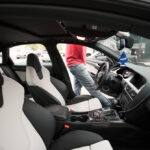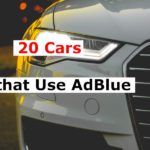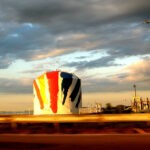10 Car Brands that Rust the Most (Don’t Buy Them)
Rusting is a really annoying thing for all car owners. The automotive industry has witnessed several rust buckets. I would recommend you to avoid those cars at all costs.
This article discusses in detail, the car brands that rust the most, and the ones that are rustproof. The article also answers several vehicle rust-related queries that might be stagnant in your mind.
1. Ford
Rusting is definitely one of the biggest problems that many Ford Owners have to deal with. Most common Ford vehicles that are notorious for rusting, include the KA, Focus, Fiesta, Bronco, and the F-150.
Besides being a cheap commuting option, the Ford KA is an absolute rust bucket. The car featured a lightweight chassis and came powered by a 1.3-liter engine. However, its rusting problems have made it extremely unrecommended in the used car market. Rust was commonly found near the door sills and fuel cap. Plus, the rear floor becomes extremely feeble due to rust.
The Ford Focus sedan and the Fiesta suffer not only from mechanical problems but also from serious rust issues, especially the older gen models.
Being an off-road SUV, the Ford Bronco is also fairly prone to rust issues. The off-road conditions act as a catalyst in developing serious rust issues on the vehicle.
Several Ford F-150 owners reported rust issues on the underbody parts of their brand new vehicles. The underbody components that were commonly rust affected include the axles, differentials, exhaust, and suspension parts.
Rusting, in general, is normal over time, especially if you drive on salty roads in winter. But the 2021 Ford F-150 swears against it because several owners reported rust on their brand new trucks. Rusting had occurred on the underbody components, which included the differentials, axles, suspension components, and the exhaust.
Also read: 3 Worst Ford Diesel Engines
2. Chevrolet
Cars back then, around the 1980s, had tremendous rust issues, and Chevrolet was no different. Famous Chevy models like the Corsica, Celebrity, Silverado, Camaro, Vega, Citation, and the Caprice were extremely prone to rust.
The main culprit here is the GM’s lackluster build quality and cheap paint quality on their vehicles. The paint used to chip away quickly, exposing the bare metal to the atmosphere.
Older generations of the Silverado (1990s to 2000s), Corsica, Celebrity, Camaros of the 1970s, 1980s, and even beyond that had numerous rust and corrosion complaints. The rust on some chevy models was so intense that those owners even suffered a few breakdowns on those vehicles.
Also read: Are Chevrolets Good Cars? 17 Things You Should Know
3. Mazda
Mazda cars are known for their great dynamics and fun-to-drive character, however, earlier Mazda models also had the tendency to catch rust pretty quickly. Mainly, it was the Mazda 3 that had been reported with the most rust issues. While some rust issues were also found on the MX 5 Miata.
Currently, the Mazda 3 is continuing its third generation avatar. But older Mazda 3 models, specifically from 2004 to 2009 had well-known rust problems. However, not all Mazdas of that generation rusted out, in fact, several owners suggested that their car either rusted out pretty quick or didn’t rust at all. Consequently, a corrosion inhibitor that was not properly applied to some earlier batch of Mazda 3, suffered from this problem.
In the more recent Mazda 3 models, say from 2014 to 2018, the only rust issues that were encountered, were related to underbody components like shock absorbers, axles, and exhaust pipes. The older Mazda models were built with minimal protection from rust on their underbody.
The NA and NB Mazda MX5 models It’s not a surprise to see the MX5 on this list. What further boosted rust issues was the dual-layer sills which trapped water in them.
4. Saturn
A subset of the General Motors, Saturn cars were utterly unreliable, and hence perished soon from the market, in the year 2010. I won’t recommend anyone to buy Saturn vehicles as those cars are absolute rust buckets. The Saturn Relay and Vue were the prime examples of that, with multiple corrosion issues.
For the Saturn Vue, it was its subframe that had serious corroding tendencies. Plus, the rear hatch components and engine cradle mounts also had the tendency to rust. The Vue was also reported to have problems with its suspension setup.
Between 2005 to 2007, GM Motors produced the Saturn Relay. The exterior of that car went through extreme damage caused by corrosion and was certainly irreparable.
5. Suzuki
Drive a Japanese car outside of Japan, and chances are that it will start to rust because the Japanese don’t utilize salts on the road during winters, so they save costs by applying no extra rust protective layer. Older Suzuki cars, especially the Swift and Aerio were quite prone to rust, owing to their cheap paint that used to peel away quickly.
The Swift was a great budget compact hatchback, certainly loved by many. The only problem was that the earlier Swift models, the ones identical to the Geo Metro, suffered a lot from rust problems. The car came with cheap paint on it, which catalyses the whole rusting process. However, if you do find a clean example of this vehicle in the used market, you can certainly go for it.
The Suzuki Aerio was also one great offering from Suzuki. Backed with a peppy engine, the Aero had some great features. But similar to the older Swifts, the car had a poor paint job and was a great rust sufferer.
Also read: Are Suzuki Cars Good? (3 Suzuki Cars to Avoid)
6. Pontiac
Pontiac made some terrible rust buckets between the late 1980s and early 1990s, and the Pontiac Grand Am was the prime example of that. Targeted as a sporty sedan, the Pontiac Grand Am was anything but a rust bucket. The Wave was another Pontiac vehicle that was nasty for rusting issues.
A 1990 Pontiac Grand Am owner reported that his comparatively brand new vehicle had terrible rusting problems. Rust could be found everywhere, from wheel arches, below the doors to even the bumpers.
The Pontiac Wave also known as G3 in the US is one of the cheapest cars that you can afford in the used car market. With a 106 hp 1.6 liter engine under its hood, the Wave offered a driving experience that was far away from being called enthusiastic. This lazy car was prone to quite a lot of rust issues globally.
Also read: 5 Cars with Thickest Sheet Metal (List)
7. Dodge
Rusting is really one of the biggest problems that many Dodge owners have to deal with. Most common Dodge vehicles that are notorious for rusting, include the Dodge Ram 1500 from its truck lineup, the famous Challenger, Charger, and vehicles from the past such as the Shadow, and the Spirit.
According to consumer reports, the Dodge Ram 1500, especially the 2006 model, had excessive corrosion and rusting issues.
As per multiple Dodge Challenger and Charger owners, these cars tend to develop rust issues after 5 to 8 years of their lifespan.
Also read: Are Dodge Parts Expensive? (with Exact Costs)
8. Mini
Old Minis had a strong affinity for rusting. Serious cost-cutting was done on those vehicles. The older Minis were built using cheap ungalvanized steel. As a result, the car faced insane amounts of corrosion issues, with rust being present almost everywhere on the body.
From the headlamp surrounds, front and rear bumper, lower windscreen surround, the pillars, window areas, below door sills to the floor fan, rear subframe, and even on the sides and the bonnet, rust could be found everywhere on the Minis.
9. Jeep
Jeeps do have rusting issues with them, mainly because they are designed to be dominant on off-road tarmac, so they comprise greater metal body parts in comparison to composite parts or plastic panels that are generally found on other vehicles.
The Jeep Wrangler has been quite nasty for rusting issues, and this certainly is something that Jeep owners worry a lot about. However, the Wrangler rusts so much, mainly because they are built for heavy-duty tasks, so they are made up of mostly stronger metal panels. This in turn increases the surface area that is exposed to the moisture present in the air and causes rusting.
Additionally, Jeep owners subject their vehicles to a lot of off-road and tough terrain abuse. Eventually, the mud and rocks on all these terrains tend to destroy the paint job of the vehicle, which ultimately puts the metal body panels exposed to the atmosphere.
10. Toyota
The Toyota brand has always been synonymous with creating one of the most reliable vehicles in the market. However, the Toyota RAV4 did swear against it. Despite being a really safe car, the RAV4 suffers from harsh rusting issues, particularly on the underbody components.
Which Cars Should You Buy if You Don’t Wish to Have Rust Problems?
Not all cars in the market suffer from rust problems. Buyers looking for rustproof cars can consider the following models:
- Audi A3
- BMW 3 series
- Volvo S60
- Lexus LS
- Hyundai Accent
- Kia Forte
- Volkswagen Golf
- Mercedes Benz C class
- Honda Civic
- Toyota Camry
Do Modern Cars Rust More?
Modern cars don’t rust easily, because they are made of high-strength steel. In fact, it’s the older gen cars that tend to be rustbuckets. Primarily cars after the 60s and 70s, because cars from that period faced extreme cost-cutting in terms of the metal and paint quality.
It is really easy to recognize why modern cars are a bit rare to rust issues. It is so because the steel utilized in the production of modern cars is hot-dip galvanised after the manufacturing process of the steel ends.
Galvanizing basically means coating the entire surface of the steel with a thin layer of zinc. This not only prevents the interaction of any steel surface with atmospheric oxygen, but also there is an electrolytic reaction that takes place between Zinc and the Iron present in the steel.
Also read: Do Newer Cars Last Longer than Older Ones? The Facts
Why Do Some Car Brands Rust and Others Don’t?
Rusting depends upon a lot of factors, and hence varies from one vehicle to the other. Foremost, rusting depends upon the quality of steel used in the manufacturing, and whether that steel was galvanized properly.
Additionally, the paint quality, age of the vehicle, and the weather conditions do make a world of a difference as far as car rust is concerned. It’s not surprising to see that brands that use good quality galvanized steel, and upscale quality of paint on their cars, suffer less from rust problems.
As mentioned before, the manufacturing time of the vehicle matters a lot. Cars manufactured between the 1980s and early 2000s are mostly rust buckets. Brands like Chevrolet, Chrysler, GMC, and Saturn which come under the General motors, were equipped with cheap quality paint.
That paint used to chip away easily, so the metal body panels underwent severe corrosion. It is exactly the same cost today. Manufacturers fitting cheaper quality materials in their cars has resulted in increased rusting issues.
How to Protect your Car from Rust even if it Tends to Rust?
Use these top tips to protect your car from rust:
Ceramic coating: Various experts suggest that ceramic coating is a powerful way to prevent your car from rusting. This involves the liquid polymer, being applied to your car’s paint. The ceramic coating forms a protective bond with your vehicle’s paint, which doesn’t break even at extreme conditions, and thus protects your car. A huge advantage of ceramic coating over general waxing is that wax needs to be applied frequently over your car, but the ceramic coatings can last over three years.
Wash your car regularly: Dirt acts as a catalyst in rusting. Try to wash your car at least once every two weeks. Follow this habit for a long period of time, and you will be surprised by the results.
Watch out for salt: Salt is one of the biggest threats to your vehicle. When integrated with water, the metal starts corroding faster on your vehicle. As a consequence, rusting happens more commonly during winters, as rock salt is present on the road. Wash your car almost once every week during winters to protect your car to some extent.
Use anti-rust spray: If you do spot some rust on your car, the best practice is to treat it before it spreads to other body parts of your car. Begin with cleaning that area first and then letting it air dry. Use an anti-rust spray once the area is free from moisture.
Keep drain plugs clear: Owners generally overlook the drain plugs during the caring of their car, but in fact, checking them properly can avoid rust. The drain plugs get clogged overtime, which ultimately allows water to collect in them. Clean these drain plugs while washing your car. These can be found along the trunk edges, hood, and under the doors of your car.






